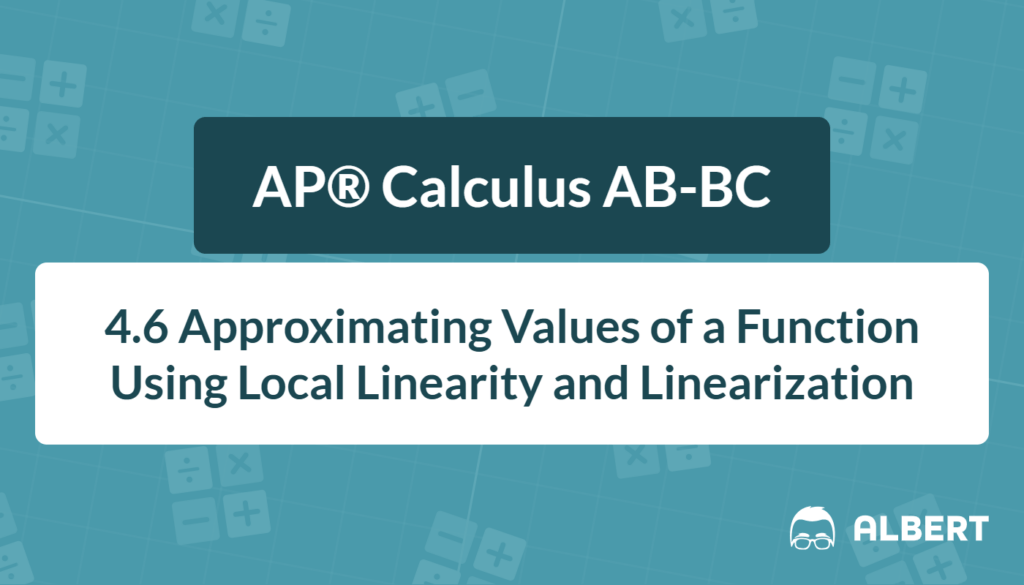Ever need an answer now but only have a pencil? Engineers, doctors, and game designers all rely on quick estimates. Linearization supplies those fast numeric snapshots. By sliding a straight line along a smooth curve, the method turns a hard function into an easy one. Therefore, students on the AP® Calculus exam often meet questions that demand this skill. Today’s review highlights the tangent line approximation formula, how to tell under‐ from overestimates, and the exact College Board objectives CHA-3.F.1 and CHA-3.F.2. Keep reading to see why linearization earns a permanent spot in any problem-solver’s toolkit.
What We Review
What Is Linearization?
Zoom-In Picture
When a smooth curve is magnified near a single point, it starts to look flat. This “zoom-in” idea is called local linearity.
Formal Definition
The linearization of a differentiable function f at x = a is
L(x) =f(a) + f'(a)(x-a)This simple line mimics the original function near a.
Graphical Viewpoint
Graph the function and draw its tangent at (a,\,f(a)). That straight line is the linearization. Therefore, moving a small horizontal step \Delta x = x-a gives an easy vertical change f'(a)\Delta x.
Example 1 – Approximating \sqrt{x} near x = 9
Step 1. Identify
f(x)=\sqrt{x}, \quad a=9Step 2. Derivative
f'(x)=\dfrac{1}{2\sqrt{x}};\Rightarrow;f'(9)=\dfrac{1}{2\cdot3}= \dfrac16Step 3. Linearization
L(x)=f(9)+f'(9)(x-9)=3+\dfrac16(x-9)Step 4. Estimate \sqrt{9.2}
L(9.2)=3+\dfrac16(0.2)=3+0.033\overline{3}=3.033\overline{3}Calculator check: \sqrt{9.2}\approx 3.03315. The line nails it!
The Tangent Line Approximation Formula
Quick Derivation
Start with the point-slope form:
y - f(a) = f'(a)(x-a).Rename y as L(x) and the result is the tangent line approximation formula above.
Key Vocabulary
- Point of tangency – where the line touches the curve
- Local linearity – curve behaves like its tangent nearby
- Differential – tiny change predicted by the derivative
Example 2 – Estimating \sin(0.2) at x = 0
Step 1. Facts
f(x)=\sin x,; a=0,; f(0)=0,; f'(x)=\cos x \Rightarrow f'(0)=1Step 2. Line
L(x)=0+1\cdot(x-0)=xStep 3. Approximate
\sin(0.2)\approx L(0.2)=0.2Graph tip: Sketch the sine curve and its tangent (the line y=x) at the origin. Notice how they overlap for small angles.
Overestimates vs Underestimates
Concavity Connection
The second derivative signals which side of the curve the tangent lies.
Quick Test
- If f''(a) > 0 (concave up), the curve sits above the tangent, so L(x) is an underestimate.
- If f''(a) < 0 (concave down), the curve sits below, so L(x) is an overestimate.
Example 3 – Natural Log Near x = 1
Step 1. Function
f(x)=\ln x,; a=1,; f(1)=0,; f'(x)=1/x,; f'(1)=1Step 2. Second Derivative
f''(x)=-1/x^{2};\Rightarrow;f''(1)=-1<0 (concave down).Step 3. Linearization
L(x)=0+1\cdot(x-1)=x-1Step 4. Estimate \ln(1.1)
L(1.1)=0.1; calculator value \ln(1.1)\approx 0.0953.Because concave down, the line gave an overestimate. Error ≈ 0.0047.
Accuracy Tips and Error Bounds
Stay Close
Smaller |x-a| improves accuracy.
Percent Error
\text{Percent Error} = \dfrac{|\text{actual} - L(x)|}{\text{actual}}\times100%Optional Bound
Mean Value Theorem can create a maximum error bound using \max |f''(c)| on the interval.
Example 4 – e^{x} near x = 0.1
Step 1. Data
f(x)=e^{x},; a=0,; f(0)=1,; f'(x)=e^{x}\Rightarrow f'(0)=1Step 2. Linearization
L(x)=1+1(x-0)=1+xStep 3. Estimate
e^{0.1}\approx L(0.1)=1.1Step 4. Compare
Actual: e^{0.1}\approx1.10517
Percent error ≈ \dfrac{0.00517}{1.10517}\times 100 \approx 0.47\%.
Therefore, the approximation is quite tight.
Why Linearization Matters on the AP® Exam
- Free-response sections love “Given a table, estimate f(3.1) with a tangent at 3.”
- Multiple-choice items connect linearization to differentials and related rates.
- Graph interpretation questions may ask whether a line gives an over- or underestimate.
Mastery of the tangent line approximation formula speeds up these tasks and guards against calculator pitfalls.
Quick Reference Chart
| Term | Meaning / Key Feature |
| Linearization | Line L(x)=f(a)+f'(a)(x-a) that approximates f(x) near x=a |
| Tangent line approximation formula | Same as above; uses point-slope form and derivative |
| Point of tangency | Point (a,\,f(a)) where the line touches the curve |
| Local linearity | Property that smooth curves look straight when zoomed in |
| Concavity | Up if f''>0, down if f''<0 |
| Underestimate | Occurs when concave up, L(x)<f(x) |
| Overestimate | Occurs when concave down, L(x)>f(x) |
| Differential | Small change dy=f'(a)dx tied to linearization |
Conclusion
Linearization acts like a mathematical microscope; it flattens tough curves into easy lines. Remember the formula L(x)=f(a)+f'(a)(x-a), apply the second-derivative concavity test, and interpret graphs wisely. Doing so secures valuable points on AP® Calculus questions that demand speed and accuracy. Practice on diverse functions, and solid intuition will follow. Quick, clear estimates will then be only one line away.
Sharpen Your Skills for AP® Calculus AB-BC
Are you preparing for the AP® Calculus exam? We’ve got you covered! Try our review articles designed to help you confidently tackle real-world math problems. You’ll find everything you need to succeed, from quick tips to detailed strategies. Start exploring now!
Need help preparing for your AP® Calculus AB-BC exam?
Albert has hundreds of AP® Calculus AB-BC practice questions, free responses, and an AP® Calculus AB-BC practice test to try out.








